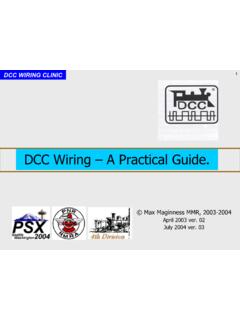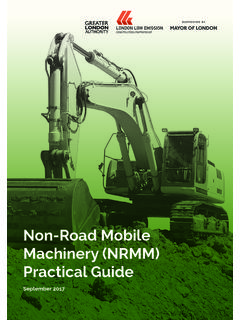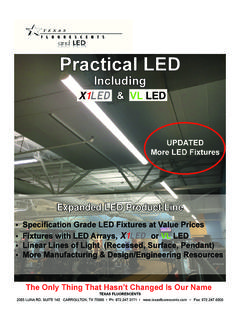Transcription of DCC Wiring – A Practical Guide. - 4dpnr.com
1 DCC Wiring CLINIC1 DCC Wiring A Practical guide . Max Maginness MMR, 2003-2004 April 2003 ver. 02 July 2004 ver. 03 DCC Wiring CLINIC2 DCC: The Prevailing Attitude Still !! ???NMRA Bulletin March 2003 p 37 DCC Wiring CLINIC3 DCC Really Is Less Complicated!!Much more information on much less wire!From: DCC Made Easy, Lionel Strang, Kalmbach 2003. DCC Wiring CLINIC4 What This Clinic Will Cover Requirements and Installation of DCC Wiring Materials and tools. Basic power and track Wiring Handling common track features turnouts, reversing loops. Tricks Demonstration Wiring CLINIC5 What This Clinic Will NOT Cover: DCC Theory (except if you ask or I can t resist.) Installing decoders in Locomotives. Programming Decoders. Competitive Equipment Comparisons Requests to wire your layout not accompanied by generous rewards. Fixing Problems if you already wired it or messed with it. (for any rewards no matter how generous).
2 DCC Wiring CLINIC6 Comparison: DC Block Wiring vs. DCC WiringLocomotive Controlled by Block Voltage and Polarity. One train per cab and blockLocomotive decodes and responds only to its own address regardless of position on track. Any number of trains per Wiring CLINIC7 DCC Wiring Needed Wiring : Track Power Bus Same regardless of Manufacturer Power Blocking or Districts on larger layouts Automatic Reversing Switch for Loops Programming Track Cab Bus Links multiple outlets for plug in cabs Varies depending on Manufacturer. Telephone wire commonly used. Not needed for very simple set ups (no walk-around) Accessory Power (optional but recommended) +/- 9 to 12 volts DC for turnouts, lights, signal power ..DCC Wiring CLINIC8 DCC Wiring Basics I With DC cab control the maximum current in a block ~1-2 Amps. Each Wiring run needs to handle just one block current. 18 AWG is ample. limited capacity of DC cab prevents high currents in a short circuit.
3 Usually recovers fast from transient problems. Often not noticed. Short in one block will shut down just that one block and train. Rest of layout is unaffected. With DCC all the current for all the trains comes from one source through one Wiring bus run. Minimum capacity provided is normally 5 Amps. Wiring needs to handle this current level. 14 AWG is minimum for track bus wire (except very small layouts.) An uncontrolled short has as much power as a 60 watt light bulb! For protection the booster trips out and shuts down very fast stopping the whole layout. The fast reaction gives zero tolerance for transient short circuits that you might not notice with DC. (Some causes can be controlled in turnouts) The overall electrical resistance must be low. A short must draw the trip current momentarily to make the protection work. ( 25 cent test ) For an existing DC cab control layout with no electrical problems at all you may be able to convert by using a DCC supply in place of one cab.
4 DCC Wiring CLINIC9 DCC Wiring Basics II With just one large block, Wiring mistakes and failures can be very hard to locate one defect anywhere and its no go everywhere. Be very careful in Wiring methods and workmanship. Leave no bare wire. Check for short circuits as you go, before the booster is connected. Simple multi-meter is fine. Select and stick with a simple color code. ( here its mostly blue and red for the rails and green for switching frog connections) Track electrical gaps are still needed but simpler to figure than with DC. 99% of all cases are covered by one set of rules. - Gap any rail coming from a turnout If in doubt gap both rails at this location. - Fill the gaps with solid insulating material. - Try the fancier track work (three way turnouts etc.) as they come before modifying. DCC Wiring CLINIC10 DCC Wiring Basics III Learn to solder well. You can make many under baseboard connections with solder-less splices, but still need to solder to the rails at least.
5 The five basics for electrical soldering: Clean all surfaces (fresh wire surfaces, no oxide on track, no track ) Clean again If any doubt clean again! Apply heat and a little rosin cored solder wire. When the initial solder runs, apply some more and stop. Keep the soldering tip clean and tinned Solder guns are not recommended, too hard to control the heat. Result must be smooth and Wiring CLINIC11 Basic Plain Track Wiring for DCC Track Feeders 20 24 gaugestranded Track Bus Wires: 10 gauge 14 gauge, solid conduit wire (14 gauge more than sufficient for 100 feet run in HO.)3 feet+ OK between feeds, closer on smaller code track. Solder rail joints between feeders and/or at least one feeder each rail than 3 feet longDCC Wiring CLINIC12 Typical Wiring Arrangement Soldered JointsTape the Joints! Secure the Tape! Finding stray connections later is very exasperating!DCC Track Power BusDCC Track Feeds Feeds to Frog switchAccessory Common+/- 9 Volts DC Accessory PowerCab BusTRACKDCC Wiring CLINIC13 Wiring Arrangements Solder less Splices Use the Correct Size splices They are color coded:- Blue = 14-16 AWG- Red = 18-22 AWG- Double over undersized wireAll materials: Lowes Wiring CLINIC14A Very Handy ToolAutomatically Adjusting Wire Stripper.
6 About $19 at the home improvement store of your wire nicks and stray Wiring CLINIC15 Track Wiring Around TurnoutsGapsTrack Power BusBOOSTER Track FeedsThere are 4 track sections (blocks) but all are fed from the same Track Power BusSwitched Turnout Frog DCC Wiring CLINIC16 Turnout Wiring How Well do Available Turnouts meet this?What is the meaning of DCC friendly ?From: Digital Command Control. Ames et al, Allt om Hobby/NMRA; 1998 DCC Wiring CLINIC17 Turnout Wiring Example, Isolated Frog. (Atlas Super Track )Insulated Tie-barRail GapsIsolated FrogStock and Point rails electrically bondedTrack Feeds For Live Frog, Add wire to switch on turnout motor or linkage DCC Wiring CLINIC18 Turnout Wiring Example (Peco code 75 optional Wiring )Insulated Tie-barRail GapsJumpers cutAll Frog Rails BondedAs Supplied Modified/Add Track Feeds added to both rails exposed in base gap. To switch on turnout motor or linkage These rails must be gappedTo Switch Motor Contacts ex factory: Wiring is equivalent to older Shinohara and adjacent rails isolated by cutting jumpersDCC Wiring CLINIC19 Turnout Wiring Example: Power Routing.
7 (Older Shinohara type) Careful Observance of Standards Gauge Clearances is Essential!Metal Tie-barsAll Frog Rails BondedTrack Feeds Contact TabsThese rails must be gappedWith electrical contacts on switch motor for better frog powering, any mistiming of point blade and contact movement causes a momentary short but enough to trip DCCX contacts on switch machineCurrent Limiter, 1156 Auto BulbDCC Wiring CLINIC20 Tricks with Auto Lamps IMomentary Shorts that would just stall one train with DC can shut down the entire layout with LimiterGoof Proof Isolated Frog Switch Switch1156 Light bulb has less than 1 ohm resistance at low current, drops full 12 volts with current limiting, booster will shut down whole Wiring CLINIC21 Tricks with Auto Lamps II1156these sections still operateThis protection is suited to a smaller layout with just one booster supply. Separate boosters can be used for each section or power district on larger layout with more than 5-6 locos running at amps limitDCC Wiring CLINIC22 Reversing Loops (+ Wyes and Turntables) IModule flips polarity of reverse loop section to match that of main line as train starts across insulated so fast that main power station does not trip FrogDCC Wiring CLINIC23 Reversing Loops (+ Wyes and Turntables) IIFrom: DCC Made Easy; Lionel Strang, Kalmbach , 2003; p27 Alternative Method: More $$$ Good for multiple train storage loops.
8 XXGapsA slight mistake in the book! > Complete Train Length between gapsDCC Wiring CLINIC24 Programming Track - ExampleExact arrangement can differ depending on command/booster configuration and manufacturer. Configuration variables (CV s) can often be set on the main but not the initial address in Demo moduleDCC Wiring CLINIC25 Summary DCC Wiring is different from DC blocks and cab control in consideration of Wiring methods, but many of the same basic rules for electrical gaps etc. still apply. Higher currents = heavier power Wiring , and overload protection must work. DCC Wiring is simpler, but intolerant of sloppy workmanship and make do practices. Electrical joints must be soldered or properly crimped gas tight Turnouts need certain attention for trouble free operation. Special devices drastically simplify reverse loops, wyes Wiring CLINIC26 References DCC Made Easy ; Lionel Strang; Kalmbach 2003 The Digitrax Big Book of DCC ; Zana Ireland ed; Digitrax, 1999 Digital Command Control ; Stan Ames, Rutger Friberg, Ed Loizeaux; Allt om Hobby, 1998 Easy Model Railroad Wiring ; Andy Sperandeo; Kalmbach, 1990 Allan GartnerDCC Wiring CLINIC27





